
TEMPLARS, MOSCOW, RUSSIA. D.ZENIN.
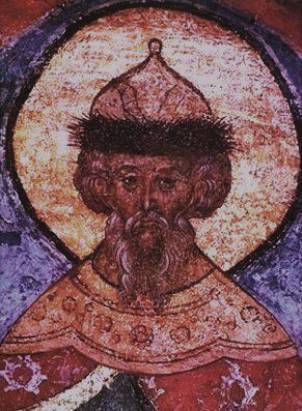
Prince Andrey Bogoljubsky
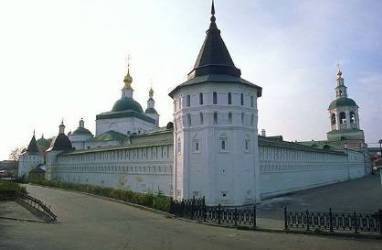
Danilov monastery in Moscow - built by Prince Daniel
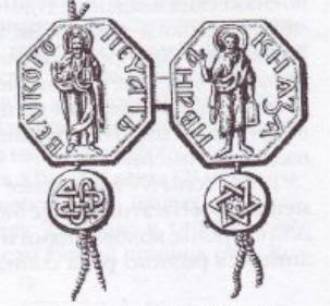
The seal of Ivan Kalita, Moscow Prince in 1325-1340
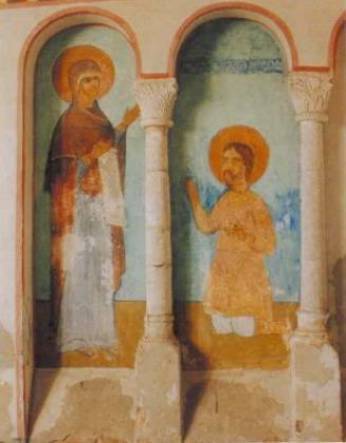
Appear of Theotokos to Prince Andrey in 1155 in Moscow. She told him to devote Moscow to Her.
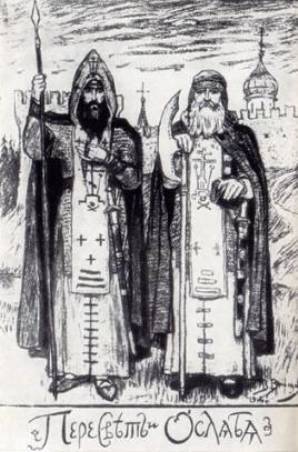
Monks-warriors Peresvet and Osliabia.
Painter V.Vasnezov.
On their tombstones - Templar symbols.
Painter V.Vasnezov.
On their tombstones - Templar symbols.
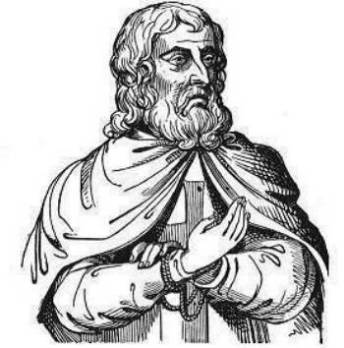
Jacques de Molay, last Grand Master of the Knights Templar Order.
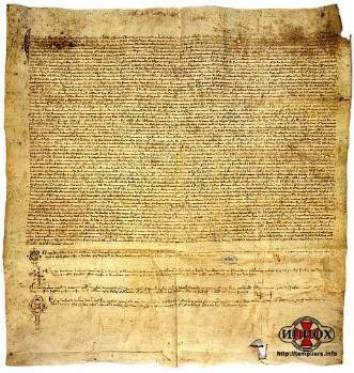
Recently published Shinon List of 1308.
Results of work of Pope comission about templars.
They are declared innocent in heresy.
Results of work of Pope comission about templars.
They are declared innocent in heresy.
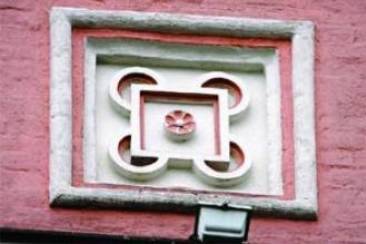
Digest from works of Dmitry ZENIN, made and translated by L.Regelson.
Already in times of Prince Oleg (879-912) Russia was included into the European family of peoples united by francs system of vassalage. In last quarter of X century Rurik dynasty has entered into kinship with ruling dynasties of German and Byzantian Christian empires.
Byzantines considered Russians as francs and have been assured of their West European origin. The social structure of Russia at that time was completely identical to a political system of the states which have developed from splinters of Franks empire at second half of X century.
From Norway to the Jerusalem kingdom the sovereigns who sat on all thrones were connected among themselves by kinship and that the most remarkable, all without an exception were relatives to Russian Rurik dynasty.
Rurik connections with Capetian dynasty is most indicative. Henry I was the husband of Anna the daughter of Yaroslav the Wise. Son of Anna Louis the Fat had the cousin to Vladimir Monomakh. Grand daughters of Anna have married: senior for Balduin I – the king of the Jerusalem kingdom, younger for Bohemond of Antioch. Rurik dynasty had family connections with emperors of Holy Roman empire of the German nation and the Byzantian emperors.
War was the form of existence of the medieval aristocracy, therefore the common house raged all the time. From these ceaseless private wars the greatest burden was suffered by the peace population and church. Therefore Christian pastors in the middle of XI century stood up for the Divine Peace.
The innovator, who has accepted such a reasonable decision, was the Roman high priest Urban II. He was very active Person - that was he who has presented to Russian clergy in 1085 a wonder-working icon and a part of relics of Nikolay bishop of Mira in Lycia.
The Pope Urban has convoked in 1095 in French city of Clermont an Ecumenical Council where he was urging aristocracy to stop private squabbles, to serve GOD, to help the east Christians suffering under oppression of Moslems, to free the SEPULCHER from hands of infidels and to build in the liberated Holy Land the DIVINE KINGDOM of JUSTICE. The Pope promised to all knights the martyr's crown and the kingdom of heaven. He has urged everyone to take the own cross. The Clermont Council became the beginning of romantic epoch of Crusades.
But what is interesting: already in the 1096 the first officially fixed Council of the Russian princes has taken place in the city of Liubech. The Council has condemned wars among princes, forbidden to spill Christian blood and obliged to be at war only with the infidels.
And this decision has been executed. Russian warriors have taken part in liberating of the Holy Land together with the European knights. Russian historian N. M.Karamzin wrote:
"Many notable Inhabitants of Kiev and Novgorod were then in Jerusalem... Russian Heroes searched dangers and glory under banners of Christ's troops".
It is not less interesting that all Russian epic warriors (bogatyrs) visited Jerusalem. Main goal was the repentance in sins after eventful life. It was not by chance that at once after liberating of Jerusalem by crusaders the RUSSIAN monastery of the Theotokos was founded.
German historian Oscar Eger, concerning participation of Russia in Crusade movement, in the end of XIX century wrote:
"This feature (religious differences) was not so great, that such all-European movements as crusades, did not find the echo in Russia, especially if take in consideration the crowds of Russian pilgrims in XI century from year to year continuously went to Jerusalem on worship to holy sites".
It is necessary to recognise that success of First Crusade, really, was a miracle. On July, 15th 1099 Jerusalem has capitulated, Muslim garrison, with wives and children, has left the Holy city, and winners have entered into it. First task of the plan has been executed.
It remains now the main thing – to build the KINGDOM OF GOD ON THE EARTH.
In accordance with the circumstances the kingdom of crusaders in the beginning of XII century became the most arranged Christian state. External danger has forced to develop the mechanisms of protection against the social arbitrariness, based on the voluntary public union.
Certainly, all this ideal system could work only in one case: if the common interest constantly forced the palestinian Christians to refuse from their private, sometimes petty, urgings. In the kingdom created by participants of the First Crusade, the new bases of the state development have been created limiting both an arbitrariness of the royalty, and willfulness of the nobility, regulating rather frictionless social life of estates.
In Europe the inner-dynasty chaos and leapfrog proceeded. The prestige of the highest authority has extremely fallen. Situation in Germany or France was not better, than in Russia. The emperor, the King and Great Kiev Prince possessed at that time only nominal power.
Suddenly, in France, Germany, England, Byzantium and on North-East of Russia, sovereigns appears who start identical internal policy – the strengthening of the central power.
Who was these sovereigns?
France – Louis VII, Germany – Frederick II Barbarossa, England – Henry II, Byzantium – Manuel I, Russia – Andrey Georgievich who had nickname Bogolyubsky. Oldest of them was Andrey Georgievich (born in 1110), the youngest was Henry II the king of England (1130).
All of them were relatives. Especially close contacts Andrey Georgievich had with Frederick Barbarossa and Manuel I. Emperors in their letters named the Russian prince the brother as equal to them.
Between these five sovereigns hidden communication existed, and all of them, except Louis VII, have finished the days tragically. They were connected with some common task.
Sovereigns got together in Constantinople during the Second Crusade 1147-1149. Fridrih, Louis, and Henry of Anjou often lived at Emperor Manuel court and communicated with him.
It is known that Andrey Georgievich had left Kiev and began wide building activity in the Rostov-Suzdal Russia. In 1152 he founded Pereslavl-Zalessky. In the city the cathedral of Theotokos have been built which precisely repeated proportion of Solomon Temple, described in Bible. Then he strengthened and fortified Moscow.
Frederick Barbarossa had sent architects to Andrey who built Gold and Silver gates in Vladimir. After the work was finished, ciborium was established – a stone stoup with the eight-pointed cross at the bottom. Such a stoup was in Jerusalem, opposite to the church of the Holy Sepulcher and it meant the centre of world.
The chronicle mentions about "city of Moscov" at first time in 1147 when Prince Yury the Long-Armed has summoned the allied princes for a campaign against Kiev. It means, already then Moscow allowed the concentration of big feudal-knightly troops. At second time Moscow mentioned in 1174 after Andrey Bogolyubsky's murder, as a city where Andrey's supporters and his son Yury took cover.
In 1262 the troops of Nogai comes back to capital of Golden Horde the Sarai-Batu. Here the dexterous intriguer Nogai celebrates his wedding with the daughter of the East-Roman emperor. Here are present: Alexander Nevsky, the metropolitan of the all Russia Kirill, magisters of Teutonic and Livonian Spiritually-Knightly Orders and... Magistrum Tempelarum.
Having celebrated the Nogai wedding, all this company goes in Vladimir where feasts anew, concerning the birth and christening of Alexander Nevsky fourth son – Daniel. Metropolitan Kirill becomes his godfather. One year passes. On November, 15th, 1263 Alexander Nevsky has died. The Russian Orthodox Church takes Daniel under protection.
Before Daniel Aleksandrovich has received Moscow, it never was a princely city. When Moscow became the princedom centre, it had no bishop, but at the same time was not a part of any eparchy!
Because Moscow was a city of the Theotokos. Moscow received this status in 1155 from Andrey Bogolyubsky who came back from Kiev with an ancient icon who subsequently has received the name "Theotokos of Vladimir". The Theotokos appeared him in the dream and told to give Her this city. That the saint prince, having woken up, at once has executed.
He has handed Moscow not to Church, but to the Theotokos!
What it meant, it is easy to guess. Who were they – the servants of Theotokos to protect the capital city Vladimir from the Kiev? TEMPLARS, there is nobody more.
It is known from chronicles in 1305-1314 that the mass arrival to Moscow of military nobility had place. These knights ("on horse in full armaments") came from the Horde, from Lithuania and "from the Germans".
Daniel descendants unexpectedly received superfluous manpower, material and the financial resources reliably providing success of their offensive activity.
Whence Moscow has received the necessary means for such impetuous development?
Process of Templars in 1307-1314 was the event which has drawn attention not only all Western Europe, but also Muslim Near and Middle East. Contemporaries named this court "terrible". Even in that severe time the obvious bias and cruelty of judges shocked all baptized and circumcised world .
One of chronicles of that time says:
"Allegedly, in one of nights before a wave of arrests the templars treasures have been taken out from Paris and are delivered in Port La Roshal where are shipped on 18 galleys which have left in an unknown direction".
In 1307 Yury Danilovich Moskovsky was in Novgorod and together with Novgorod archbishop and all people have met "kaliks" (wanderers - pilgrims), who arrived on 18 "nasadas" (the seaworthy ship). We will notice that Rabelais, the French author of the end XIV has described a seaway to Russian northern ports round Scandinavia. Kaliks have brought "infinite many set of gold treasury, pearls and precious stones", and gave all that to prince Yury, to archbishop and to all people; after then wanderers have complained on "unworthy king of Gaul and the Pope".
All attempts to find treasures of templars in the Western Europe have finished unsuccessfully.
Geographical position of Moscow and that she as Rome, Jerusalem and Constantinople is located on seven hills, allows to assume that Moscow has been selected by builders of the Divine Kingdom on the earth as capital after attempt to construct this Kingdom in Palestine on a place of ancient Israel has failed.
Data about templars in West Russia are in the Hypatian Codex. Narrating about events of 1245, the author tells that Daniel of Galicia had appealed to the troops with words:
"It is not fit that TEMPLICHY called SOLOMONOCHY to hold our fatherland..." – and he has gone on them and "took their elder Bruno".
It is known that templars was visiting Golden Horde regularly already at the time of Batu Khan. It would be especially convenient for them, if Moscow was the commandery of templars.
Abu al-Ghazy, Khan of Khiva and descenant of Chinghiz, the author of History of Tatars telling about events by of campaign 1237-1238, tells about a capture of Moscow:
"Moskovits and their friends FRANKS (inhabitants of the western countries in general), have made an entrenchment and strongly fought from it. Batu has stood forty days and could make nothing, before his brother Shejbani with 60000 warriors has approached. Having seen such multitude, moskovits and FRANKS have thrown an entrenchment and ran in wood".
Russian chronicles narrated about a capture of Moscow: "godless people have burnt Moscow and killed voevoda [chief of troops] Phillip Nianka [nurse-maid]". Who is this Phillip and why any other "nurse-maid" does not mentioned in chronicles – the reasonable answer does not exist. But if to read the medieval text so: "... Voevoda PHILLIP FROM NANCY was killed" – all become clear. Abu al-Ghazy specifies:
"Muscovites and their friends GERMANS dug round moat near Moscow on January, 20th and three months stood up to Tatars...".
It is well-known that some Daniel, "the hegumen [abbot] of Russian Land", has visited the Jerusalem Kingdom in the first years of its existence and met there king Balduin I. After an unsuccessful campaign of crusaders to Egypt he paid the ransom for the captured king of crusaders. He dwelt in the Russian monastery of the Saint Savva located on territory of ruins of Solomon Temple (!). It is clearly that Daniel was accompanied by the big retinue, but the main thing is in other. Hegumen has met in the Divine City the fellow countrymen: from NOVGOROD, KIEV, SUZDAL and ... ALL THE DRUZHINA [SQUAD]!!!
The habitants of Novgorod were considered in the Middle Ages among of the best seamen of the world, templars also have quickly mastered a seamanship and confidently ploughed boundless open spaces of the seas. If the trading station of Novgorod was settled in Jerusalem near the TEMPLE why could not such station of their colleagues, to mutual benefit, be placed in the Novgorod?
All what the king of France desired so strongly – manpower and financial resources had completely disappeared in the centre of the Western Europe – and have emerged in the deaf northeast region. Correctly invested and on a large scale applied, these treasures (as well as templars themselves, with their skills and knowledges) have changed a political card of Russia in the face of one generation. Moscow has made a qualitative leap: has turned up as capital of church and state!
To see the traces of Tampliers in Moscow, it is not necessary to make difficult and long searches. It is enough to walk at walls of the Danilov Monastery. On the first storey of gateway churches – the rosettes in the form of the Templars coat of arms! The white square framework, four rings on the corners of square, in the centre the rose with six petals! The main combination of colours: white – innocence, red – blood! Templars especially esteemed colours: red, white, yellow – wisdom, and black – mystery.
Alexander Peresvet, the hero of battle on Kulikovo field, was the prior of the Simonov monastery. His companion, the hero of the same fight, Rodion Oslyabya, was the prior of Danilov monastery, decorated with templars symbolics. Both heroes are buried in a side-altar of Theotokos church of the Simonov monastery. It is possible to look here at Peresvet and Osljabi gravestone also decorated with symbolics of knights of Templ.
Templars, condemned to a fire by the king of France Phillip de Faire and Pope Climent, have found not only a refuge, but also hearty welcome in Russian land. They had considerable influence on her life and have left the traces, well distinguishable even presently.
Later the Russian State which has grown from the Moscow princedom, long time served as reliable shelter for the Catholic spiritual organisations.
In 1525, after defeat in war with Poland, a considerable part of Teutonic knights not going to accept Luther heresy, has moved to Vasili III to Moscow.
Thirty years later the turn has come for Livonian Order to be divided into Lutherans and Catholics; the last have come running to the son of Vasily Ivan the Terrible and have involved he in war against "insult to God". After unsuccessful end of war and division of Livonia between Catholic Poland and Protestant Sweden, the considerable part of the population of Livonia, the nobility, merchants and the simple people, both Catholics, and Protestants, has for ever moved to Russia.
In time of Catherine the Great the Jesuits were expelled from everywhere have found a shelter in Russia. Hospitalliers were also expelled from all their possession by army of revolutionary France and have found the second native land in the Russian empire under a majestic hand of emperor Pavel.
So descendants of Templars, persecuted and plundered by Catholic Europe, by their lavish mercy covered with shame the descendants of Hospitalliers who betrayed them almost 500 years ago.
Researchers of the Moscow period of the Russian past constantly run into the same error: inexorable order-monastic discipline they name "slavish humility" and search for roots of it in "domination of Tatars". But the inexorable discipline of the monk is not humility of the slave. So it is necessary to search for roots of this Russian discipline in the West European knight's castles.
Process of new state building: not the anarchical union of barons, but centralised, soldered by iron discipline, the general will and a plan – it was begun by Moscow and by her adopted children, Templars – by innocent victims, knights of the Theotokos.

